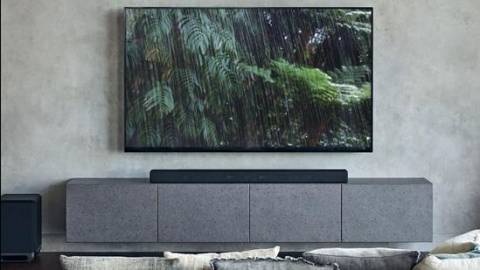
Sony A7000 avant-garde soundbar takes advantage of a free run as Bose naps
If you are spending around ₹1,77,980 on a soundbar for your TV, there is very little room for compromise or rough edges. That’s exactly what the new Sony A7000 soundbar costs, with the SW5 wireless subwoofer. The features list making for favourable reading does help – Dolby Atmos, spatial audio and powerful audio hardware in place including two up-firing speakers (these are speakers which direct the sound towards the ceiling, for the bounce-back Surround effect). We had the chance to use just the soundbar, and fully kitted out with the wireless sub and rear speakers, and you really are getting a lot of bang for the buck.
The first impression of the Sony A7000 is that it is massive. In fact, it is a few inches wider than a 55-inch TV we have tested this with. Keep in mind, you’ll need a table wide enough. Or a wall that doesn’t have any fixtures getting in the way. Not difficult to imagine why the dimensions are generous. There are five front-facing speakers, dual built-in subwoofers (these also look towards you) and dual up-firing speakers. Look closely, and you’ll notice cut-outs on either flank to bounce sound off walls and furniture.
All said and done, the design doesn’t really have a standout element. Despite a premium price tag, the Sony A7000 does not get any special treatment. There are examples. Bose has always done soundbar designs very nicely (though the brand seems to be in hibernation mode now), with a generous touch of sophistication. Sonos with the Arc (that’s around ₹99,999) also has that unique design going its way, though it isn’t as powerful. Plus, minimalism takes a bit of a hit with that single-line display Sony has plastered on the front of the A7000 – this just feels out of place. And that glossy layer on the top is a dust magnet.
There are two ways to connect the Sony A7000 to your TV. One is an audio-out from the TV to this, either via optical-out or the HDMI ARC (or audio return channel). You would want to choose the latter, for Dolby Atmos support for content on platforms such as Netflix. The other method is connecting the source device to this, such as a media player (Apple TV or Amazon Fire TV Cube comes to mind) or a gaming console (Sony PlayStation 5 for instance), and use the HDMI out option to connect to the TV.
This soundbar will support content that is 8K with HDR, 4K with HDR and the Dolby Vision HDR format. HDR is high dynamic range, which adds a lot more detailing to the visuals on screen. Chances are, your TV will be able to take advantage of most of these features, if you’re shopping for a soundbar in this price bracket.
There’s also the built-in Google Chromecast support, and the Sony A7000 will show up as a speaker you can stream to in your Spotify app, via Spotify Connect. Use the companion app for smartphones (Sony Music Center; free for Android and iOS) to set up the voice assistants too. At this time, your choice is between Amazon Alexa and Google Assistant. That being said, a massive soundbar being used as a smart speaker would likely be categorised as over-doing things.
Sony doesn’t say what the exact dimensions of the speaker units are, but there is a definite revisiting of the dynamics. The front facing, upward firing and the subwoofer units aren’t circular, as you may imagine. They are instead, rectangles. The idea is to increase the diaphragm area, which should theoretically result in less distortion, particularly at higher volumes.
The results are there to be enjoyed. In ‘Don’t Look Up’, there was that width of sound which most other soundbars aren’t able to replicate, and this is one of the perfect titles to play to get a good idea of what the vertical surround sound feels like. Or you can choose any of the Fast And Furious movies, and the car chase scenes sound much better as the sound moves around you. Everything just sounds that much more vibrant is you’ve got the rear surround speakers too (the SA-RS3S will cost you another ₹30,999) – but even without it, you won’t feel the sound lacking. Just a small observation, the rear speakers would be ideal for a large room, but an overkill for anything smaller.
Switch over to vocals with something like Space Force or Undercover or Midnight Mass, and you’ll quite enjoy the delivery. You would have noticed that most of the content we are mentioning here is available in Dolby Atmos format. With the wireless subwoofer unplugged, the built-in subwoofer on the Sony A7000 sounds extremely restrained (that’s also perhaps the reason why you may want the separate subwoofer) and the illusion of booming bass doesn’t creep in at all. That’s a good thing for many. In fact, it sounds a little less powerful than anything Sonos’ soundbars manage.
The takeaway is the Sony A7000 is quite nicely spec-ed out with the option to add more bits too. You can be rest assured this is as futureproof as a soundbar can be, at this time. The hardware is knuckled down, the features list is ticking off the checklist and a plethora of connectivity options for flexibility. You may look at the price tag and think that the Sonos Arc may be a better bet, but you’ll need to buy the separate subwoofer as well, and this is what you’ll end up with – ₹1,84,998 (that’s for the Arc and the Gen 3 Sub). And that just doesn’t have as wide an array of audio drivers in play, or the 8K support. The Sony A7000 does deliver on every front, except perhaps the visual element of it all.
Sign on to read the HT ePaper epaper.hindustantimes.com